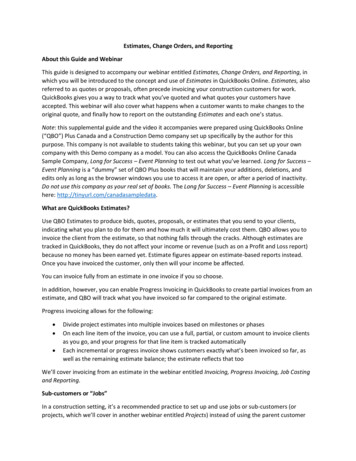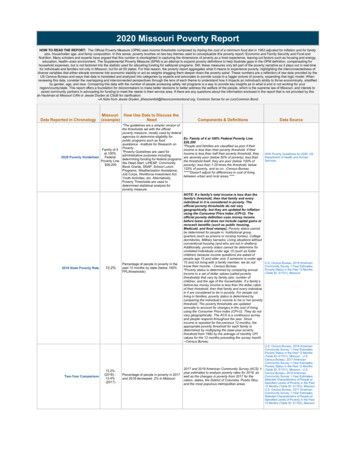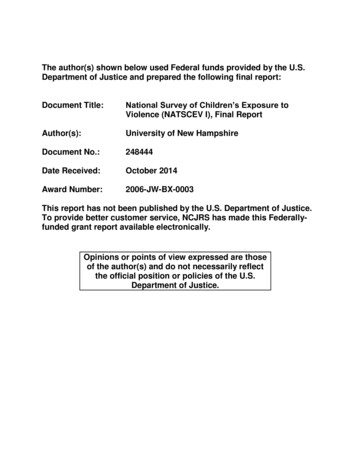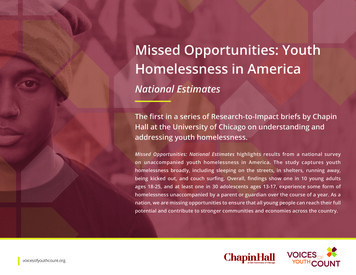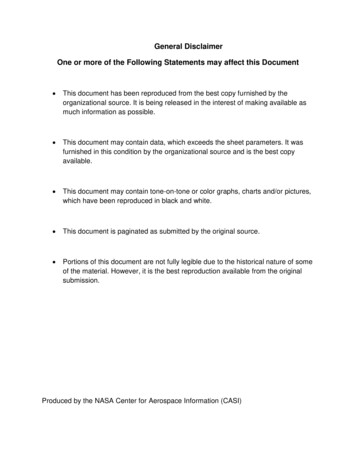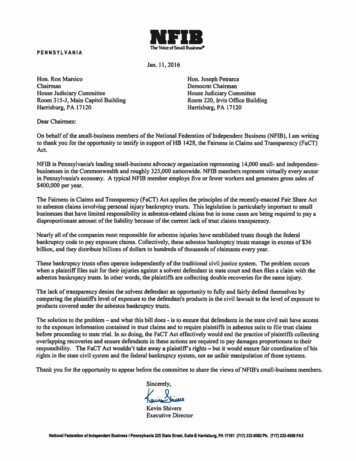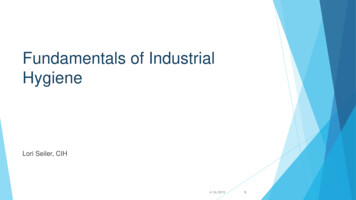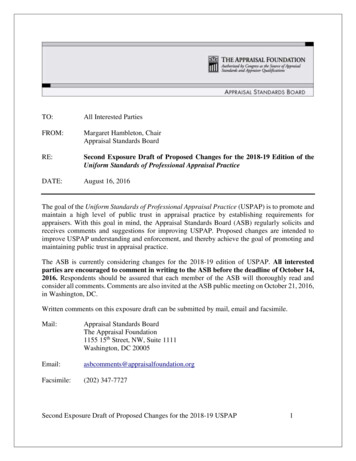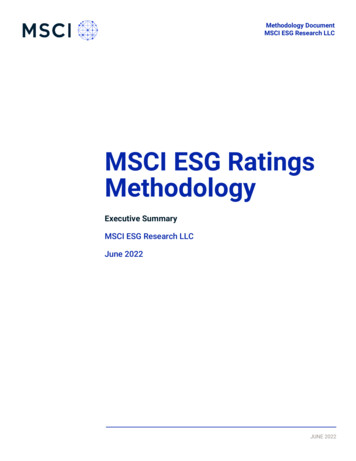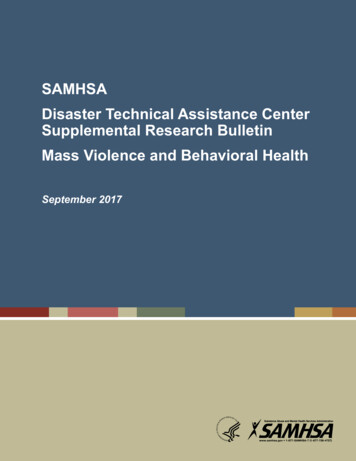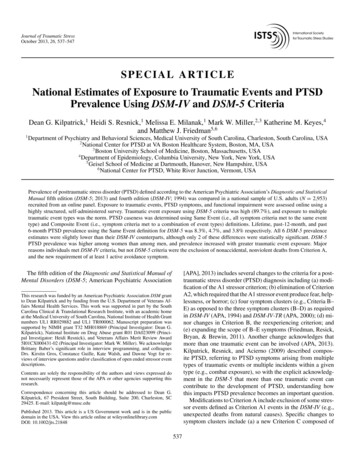
Transcription
ISTSSJournalof Traumatic StressOctober 2013, 26, 537-547International Societyfor Traumatic StressStudiesSPECIAL ARTICLENational Estimates of Exposure to Traumatic Events and PTSDPrevalence Using DSM-IV and DSM-5 Criteria,Dean G. Kilpatrick,1 Heidi S. Resnick,1 Melissa E. Milanak,1 Mark W. Miller,2 3 Katherine M. Keyes, 4and Matthew J. Friedman 5 ,61 Department of Psychiatry and Behavioral Sciences, Medical University of South Carolina, Charleston, South Carolina, USA2 National Center for PTSD at VA Boston Healthcare System, Boston, MA, USA3 Boston University School of Medicine, Boston, Massachusetts, USA4 Department of Epidemiology, Columbia University, New York, New York, USA5 Geisel School of Medicine at Dartmouth, Hanover, New Hampshire, USA6 National Center for PTSD, White River Junction, Vermont, USAPrevalence of posttraumatic stress disorder (PTSD) defined according to the American Psychiatric Association's Diagnosticand StatisticalManual fifth edition (DSM-5; 2013) and fourth edition (DSM-IV; 1994) was compared in a national sample of U.S. adults (N 2,953)recruited from an online panel. Exposure to traumatic events, PTSD symptoms, and functional impairment were assessed online using ahighly structured, self-administered survey. Traumatic event exposure using DSM-5 criteria was high (89.7%), and exposure to multipletraumatic event types was the norm. PTSD caseness was determined using Same Event (i.e., all symptom criteria met to the same eventtype) and Composite Event (i.e., symptom criteria met to a combination of event types) definitions. Lifetime, past-12-month, and past6-month PTSD prevalence using the Same Event definition for DSM-5 was 8.3%, 4.7%, and 3.8% respectively. All 6 DSM-5 prevalenceestimates were slightly lower than their DSM-IV counterparts, although only 2 of these differences were statistically significant. DSM-5PTSD prevalence was higher among women than among men, and prevalence increased with greater traumatic event exposure. Majorreasons individuals met DSM-IV criteria, but not DSM-5 criteria were the exclusion of nonaccidental, nonviolent deaths from Criterion A,and the new reauirement of at least 1 active avoidance symptom.The fifth edition of the Diagnostic and StatisticalManual ofMental Disorders (DSM-5; American Psychiatric Association[APA], 2013) includes several changes to the criteria for a posttraumatic stress disorder (PTSD) diagnosis including (a) modification of the Al stressor criterion; (b) elimination of CriterionA2, which required that the Al stressor event produce fear, helplessness, or horror; (c) four symptom clusters (e.g., Criteria BE) as opposed to the three symptom clusters (B-D) as requiredin DSM-IV (APA, 1994) and DSM-IV-TR (APA, 2000); (d) minor changes in Criterion B, the reexperiencing criterion; and(e) expanding the scope of B-E symptoms (Friedman, Resick,Bryan, & Brewin, 2011). Another change acknowledges thatmore than one traumatic event can be involved (APA, 2013).Kilpatrick, Resnick, and Acierno (2009) described composite PTSD, referring to PTSD symptoms arising from multipletypes of traumatic events or multiple incidents within a giventype (e.g., combat exposure), so with the explicit acknowledgment in the DSM-5 that more than one traumatic event cancontribute to the development of PTSD, understanding howthis impacts PTSD prevalence becomes an important question.Modifications to Criterion A include exclusion of some stressor events defined as Criterion Al events in the DSM-IV (e.g.,unexpected deaths from natural causes). Specific changes tosymptom clusters include (a) a new Criterion C composed ofThis research was funded by an American Psychiatric Association DSM grantto Dean Kilpatrick and by funding from the U.S. Department of Veterans Affairs Mental Health Services. This work was supported in part by the SouthCarolina Clinical & Translational Research Institute, with an academic homeat the Medical University of South Carolina, National Institute of Health Grantnumbers UL1 RR029882 and UL1 TR000062. Manuscript preparation wassupported by NIMH grant T32 MH018869 (Principal Investigator: Dean G.Kilpatrick), National Institute on Drug Abuse grant R01 DA023099 (Principal Investigator: Heidi Resnick), and Veterans Affairs Merit Review Award5I01CX000431-02 (Principal Investigator: Mark W. Miller). We acknowledgeBrittany Baber's significant role in interview programming, and colleaguesDrs. Kirstin Gros, Constance Guille, Kate Walsh, and Dawne Vogt for reviews of interview questions and/or classification of open ended stressor eventdescriptions.Contents are solely the responsibility of the authors and views expressed donot necessarily represent those of the APA or other agencies supporting thisresearch.Correspondence concerning this article should be addressed to Dean G.Kilpatrick, 67 President Street, South Building, Suite 200, Charleston, SC29425. E-mail: kilpatdg@musc.eduPublished 2013. This article is a US Government work and is in the publicdomain in the USA. View this article online at wileyonlinelibrary.comDOI: 10.1002/jts.21848537
538Kilpatrick et al.active avoidance symptoms that were previously part of abroader Criterion C in the DSM-IV; (b) a new Criterion D(negative alterations in cognition and mood associated withthe traumatic event/s) that contains some symptoms from theDSM-IVCriterionC, as well as some substantially modified andnew symptoms; and (c) a new Criterion E (marked alterationsin arousal and reactivity associated with the traumatic event/s)that includes one new symptom (reckless or self-destructivebehavior) and subtle modifications to other symptoms.How these changes will affect PTSD prevalence is unclear.Some argue that there will be little or no impact (e.g., Frueh,Elhai, & Acierno, 2010). Conversely, McFarlane (2011) suggested that DSM-5 PTSD prevalence may be reduced by thenew requirement for at least one active avoidance symptom.To our knowledge, only two published studies have examinedthese issues. Elhai and colleagues (2012) used a conveniencesample of college students who completed a web survey ofexposure to the DSM-IV Criterion Al and DSM-5 Criterion Atraumatic events and ratings of PTSD symptom intensity duringthe past month to their only event, or most distressing event,using a modified form of the PTSD Symptom Scale (PSS-SR;Foa, Riggs, Dancu, & Rothbaum, 1993). Past-month PTSDprevalence was higher, although not significantly so, using theDSM-5 versus the DSM-IV criteria. Limitations of this studyincluded use of a convenience sample of college students and aself-report checklist measuring PTSD.A second study compared past-month PTSD prevalencebased on DSM-IV and DSM-5 criteria using a nonprobabilitysample of 185 volunteers for studies on trauma and health recruited from an academic medical center and Veterans Affairs(VA) medical center (Calhoun et al., 2012). The ClinicianAdministered PTSD Scale (CAPS) was used to assess PTSDusing DSM-IV criteria, and four new items were constructedto measure new or substantially modified DSM-5 PTSD symptoms (i.e., D2, D3, D4, and E2). Using DSM-IV criteria, 98%had a Criterion Al event, 95% met the criteria for Al and A2,and 89% met DSM-5 Criterion A. Using DSM-IV criteria, 50%met criteria for PTSD. The estimated prevalence of PTSD using DSM-5 criteria was 52%. The authors provided a series ofestimates for the projected DSM-5 prevalence across a range ofbase-rate estimates for the DSM-IV and predicted that DSM-5prevalence would be substantially higher than DSM-IV prevalence if true DSM-IV prevalence was at lower levels of between5% and 11%. As noted by the authors, limitations in the sample(e.g., overrepresentation of racial minorities, a nonprobabilitymethod of sample selection, high PTSD prevalence) limit theability to generalize findings to adults in the general population, but strengths included using the CAPS to measure PTSD.In summary, although there are different predictions about theimpact of changes in the DSM-5 on PTSD prevalence, researchhas produced conflicting results and has not addressed the issuewithin samples that would permit generalization to adults in thegeneral population.Therefore, the major objectives of this study were to determine: (a) national estimates of exposure to DSM-IV and DSM-5Criterion A events; (b) national estimates of DSM-IV andDSM-5 PTSD prevalence based on meeting symptom criteria included in the DSM-5 to a single Criterion A event type(Same Event) or to multiple Criterion A event types (Composite Event); (c) reasons for differences in meeting criteria asdefined in the DSM-IV and the DSM-5; (d) sex differences inPTSD prevalence; and (e) the conditional probability of PTSDas a function of specific Criterion A event types and numbersof types of event exposure.MethodStudy OverviewThe National Stressful Events Survey (Kilpatrick, Resnick,Baber, Guille, & Gros, 2011) was conducted with a large sample recruited from an online panel of U.S. adults, and participants were assessed for exposure to DSM-IV and DSM-5 Criterion A events, as well as for PTSD symptoms and distress orfunctional impairment associated with PTSD symptoms. TheNational Stressful Events Survey assessment measure was aself-administered, highly structured survey completed onlinethat mirrored the format of an interactive structured clinical interview by using a conditional branching format that includedfollow-up questions contingent on prior responses. Also, questions measuring exposure to Criterion A events and PTSDsymptoms were developed with input from and review by theDSM-5 Sub-work Group to ensure that the wording capturedthe content of events and symptoms as intended.ParticipantsThe sample was recruited from an active panel of adults whowere participating in Survey Sampling International (Shelton,CT), a research sampling company that provides potentialsurvey sample participants for university-based and other typesof survey research. Survey Sampling International maintainsweb panels of potential research participants matched to U.S.Census demographics from all geographic regions of the UnitedStates who are invited to participate in web surveys. Eligiblepanel participants for this study were stratified based on sex andage categories within the U.S. Census breakdown of the population. Potential participants received a general invitation fromSurvey Sampling International stating that they were eligibleto participate in a survey. Those interested clicked on a linkthat took them to a website at the Medical University of SouthCarolina that contained the National Stressful Events Survey.This web survey, which was programmed using the ResearchElectronic Data Capture system (Harris, Thielke, Taylor,Gonzalez, & Conde, 2009), contained an introduction andcheckbox for the participant to indicate that he or she was18 years old or older and that they agreed to participate in thesurvey. The introduction stated that the survey concerned theextent to which people had experienced stressful life events andhow being exposed to those events affected them. They weretold that it was important for people to participate whether orJournalof Traumatic Stress DOI 10.1002/jts. Published on behalf of the International Society for Traumatic Stress Studies.
DSM-5 PTSD Prevalencenot they had experienced stressful events and whether or notthe events had affected them. The survey was anonymous, andstudy procedures were approved by the Medical University ofSouth Carolina Institutional Review Board. Participants whocompleted the survey received points worth approximately 3and were entered into a raffle with a prize equivalent to 25,000held every 3 months for which participants completing alltypes of Survey Sampling International surveys were eligible.According to the 2010 U.S. Census, 19.8% of U.S. householdscurrently lack home-Internet access, but some individuals fromthese households have Internet access through smartphones.Therefore, although this sampling method does not yield a truenational probability sample, it provides a diverse nonconvenience sample that is generally demographically and geographically representative of U.S. adults. The field period for datacollection was September 21-29, 2010, so a large number ofinvitations were sent out. Because the survey was terminatedwhen the allotted number of interviews was completed, wecannot ascertain how many individuals received invitations orthe proportion of those receiving invitations that accessed thewebsite; however, 3,756 adults accessed the website containingthe National Stressful Events Survey description and survey,and 3,457 (92% cooperation rate) agreed to participate. Ofthose, 2,953 completed the survey (85.4% completion rate forthose who agreed to participate and 78.6% completion rate forthose who accessed the website). Survey data were weightedby age, sex, and race/ ethnicity based on the 2010 U.S. Census.Sex, age, and race/ ethnicity characteristics of the sample areincluded in Table 1.Table 1DemographicCharacteristicsof aleFemaleAge (years)18-2425-3435-4445-5455-6465 or olderRace/ethnicityWhiteBlackNative AmericanAsian/Pacific IslanderSome other raceTwo or more racesHispanic ethnicityHispanicNon-Hispanic539MeasuresAssessment of exposure to stressful events. Twenty-fiveclose-ended questions measured exposure to DSM-IV or DSM5 Criterion A events. Questions were prefaced by introductoryremarks that provided an overview and definition of the typesof events that were asked about and encouraged disclosure.For example, the introduction to questions measuring personalexperiences of interpersonal violence included the followingstatement:Many people tell us they have been victims of interpersonal violence. When we say interpersonal violence, wemean that someone was physically attacked or sexually violated by another person. These situations can be difficultto talk about, and they can happen at any time during yourlife, even when you are a child. The person committingthe violence isn't always a stranger but can be a parent orother relative, friend, romantic partner, someone else youknow well, or even a spouse. These experiences can be extremely stressful and are not always reported to authoritiesor discussed with others. These things can happen to menas well as women.Three questions were asked about other events (i.e., other thanthose they had been asked about in the close-ended questions)that produced physical injuries, fear of being seriously injuredor killed, or a potential "other" event defined as "any extraordinarily stressful situation or event other than the ones that Ihave asked about." Those who had experienced any of the threeother stressful events were asked to provide a written description of that experience. Those responding affirmatively to oneor more of the 28 screening questions were asked a series offollow-up questions to determine (a) how many times they hadexperienced stressful events; (b) which event they experiencedfirst; and (c) if they had experienced multiple events, which onewas the worst. For the purpose of these follow-up questions andfor subsequent questions regarding PTSD symptom attributionto events, participants were presented with an abbreviated listof 14 event-type categories (representing a summary of major event types assessed using the initial 28-item screen). Thisincluded nine event types that would meet Criterion Al as described in the DSM-IV and Criterion A as defined in the DSM-5(i.e., accident/fire, disaster, exposure to hazardous chemicals,combat or presence in a warzone, physical or sexual assault,witnessing physical or sexual assault, harm to a family memberor close friend due to violence or accident, death of a familymember or close friend due to accident or violence, witnessinga dead body or body parts), a 10th event type that would onlymeet DSM-5 Criterion A (i.e., repeated or extreme exposureto aversive details of a traumatic event(s) not including exposure through electronic media, television, movies, or picturesunless this exposure is work-related); an 11th event type thatwould only meet DSM-IV Criterion A (death of a family member or close friend that was not violent or accidental), and thethree other types of stressful events (other events resulting ininjury, perceived as potentially life threatening, or perceivedJournal of TraumaticStress DOI 10.1002/jts. Published on behalf of the International Society for Traumatic Stress Studies.
540Kilpatrick et al.as extraordinarily stressful). We combined physical or sexualassault for the purpose of symptom attribution as "direct interpersonal violence," which has been consistently identified as aclass of events most likely to result in PTSD (e.g., Ozer, Best,Lipsey, & Weiss, 2003; Resnick, Kilpatrick, Dansky, Saunders,& Best, 1993).Descriptive information was collected about the first eventas well as the worst event (if applicable) including age at timeof event and whether the participant thought they might beseriously injured or killed, experienced a panic attack during or shortly after the event, and/or experienced emotions offear, anger, sadness, horror, violation of trust or embarrassment/shame during the event. Endorsement of fear of death orserious injury, experience of panic or other emotions was used todetermine whether DSM-IV A2 criterion was met. In summary,the strategy used for assessment of exposure to stressful eventswas considerably more comprehensive than that typically usedin many epidemiological studies, which often use checklists ofevents with limited introductions or follow-up probes. Therefore, it is likely that the approach used in the National StressfulEvents Survey resulted in greater disclosure of traumatic eventsthan would have occurred had a simple checklist of events beenused.Assessment of PTSD symptoms and functional impairment. For each of the 20 DSM-5 PTSD symptoms endorsed,a series of follow-up questions was presented. These obtainedinformation about symptom recency; for symptoms present during the past month, participants were asked how much they hadbeen bothered by the symptom during that month based on a 5point scale (1 Not at all, 5 Extremely). For symptoms thatreferenced traumatic events (i.e., symptoms B 1, 2, 3, 4, and 5;C1 and 2; D1 and D3), the first follow-up question determinedwhich event type(s) were incorporated in the symptom content(e.g., what event or events were involved in the content of nightmares). For remaining PTSD symptoms not referencing specificevents, the first follow-up question asked if the symptom beganor got worse following an event or events. If they respondedyes, they were asked which event type(s) occurred before thesymptom began or got worse. Participants endorsing symptomswith content related to and/or onset or worsening following astressor event were then presented with the abbreviated list of14 event types described above, and asked to indicate whichevent type(s), if any, were related to symptoms. Selection ofmore than one event type was allowed.Functional impairment as defined by the DSM-IV and theDSM-5 was assessed by five questions measuring how distressing it was when they had PTSD symptoms on a 5-point scale(1 Not at all, 5 Extremely), and whether PTSD symptomsproduced problems with employment and in their personal life,relationships, or school. Functional impairment was positive ifPTSD symptoms were quite a bit or extremely distressing forthem, or they reported problems in one or more of the four areasof functioning.ProcedureCases in which other events were reported in the eventscreening section were reviewed only if they were identifiedas an event that led to development/worsening or were relatedin content to all necessary symptom criteria to meet PTSD atthe diagnostic level according to the DSM-IV or the DSM-5using the Same Event PTSD definition described below. Narrative responses were reviewed by four doctoral-level PTSDexperts after familiarizing themselves with the DSM-IV andDSM-5 Criterion A definitions and the interview question content assessing DSM-IV and DSM-5 Criterion A events. Reviewers determined whether each open-ended event met Criterion Adefinitions in the DSM-IV, the DSM-5, or both. In cases of raterdisagreements, events were coded using a consensus process.For events that met the definition for DSM-IV Criterion Al,descriptive information about the first and worst event wasexamined to determine if the Al event also met the DSM-IVdefinition for Criterion A2.Two methods were used to determine PTSD. The first methodrequired that symptom thresholds for DSM-5 Criteria B (n 1), C (n 1), D (n 2), and E (n 2) be met to a combination of DSM-5 Criterion A event types. Thus, all symptomcriteria thresholds must be met, but they could be met in response to any combination of Criterion A event types. This wasdesignated the Composite Event PTSD definition. The secondmethod required Criteria B, C, D, and E symptom thresholdsto be met to the same Criterion A event type. Both Composite Event and Same Event PTSD definitions also required thefunctional impairment criterion to be met, indicating that thePTSD symptoms produced significant distress and/or impairment in functioning. Similar methods were used to determineComposite Event and Same Event PTSD based on the DSM-IV.PTSD prevalence was determined for three periods: (a) lifetime (i.e., met criteria at any time), (b) past year (i.e., metcriteria during the past 12 months), and (c) past 6 months (i.e.,met criteria during the past 6 months). Lifetime, past-year, andpast-6-month prevalence was calculated using Composite Eventand Same Event definitions based on both the DSM-IV and theDSM-5.Data AnalysisThe Research Electronic Data Capture platform (Harris et al.,2009) was used to program the National Stressful Events Survey questionnaire and to record all survey data. All prevalence algorithms were computed as defined above using syntaxprogrammed in SPSS 20. Taylor-series linearization was usedfor all standard error estimation given the weighted designof the study. The SAS-Callable SUDAAN software (Version11.0; Research Triangle Institute, 2012) was used to generate weighted survey data, prevalence estimates, and X2 tests.The z-score comparisons with other prevalence data were estimated with weighted prevalence estimates and survey-adjustedstandard errors to compare whether PTSD prevalence wassignificantly different between the DSM-IV and the DSM-5.Journalof TraumaticStress DOI 10.1002/jts. Published on behalf of the International Society for Traumatic Stress Studies.
DSM-5 PTSD PrevalenceDifference scores were created and discordant pairs (e.g., diagnosis positive based on the DSM-IV, diagnosis negative basedon the DSM-5) were analyzed using a dependent sample t testin Stata 12.ResultsTraumatic Event ExposureMost respondents (89.7%) reported exposure to at least oneDSM-5 Criterion A event (see Table 2). For comparison withother studies, we report the separate prevalence of direct sexual or physical assault by sex. The prevalence of either type ofdirect interpersonal violence victimization was 53.1% (58.6%of women and 47.1% of men), which included childhood physical abuse, aggravated assault (physical assault with a weapon,or with intent to kill or seriously harm perceived by the victim), rape, and other sexual assault (see Table 2). Prevalence ofsexual assault victimization was 29.7% overall (42.4% amongwomen and 15.8% among men). Physical assault victimizationwas 43.7% overall (44.9% of women and 42.4% of men).Six DSM-5 Criterion A event types were experienced by 30%or more of the sample (see Table 2). Many participants had beenexposed to more than one type of DSM-5 Criterion A event. Themodal number of DSM-5 Criterion A event types within the fullsample was 3 (M 3.30, SD 2.32).541Estimated Prevalence of PTSDLifetime, past-12-month, and past-6-month prevalence estimates of PTSD using the DSM-5 and current DSM-IV criteriaare included in Table 3. Separate prevalence estimates basedon Same Event and Composite Event PTSD definitions areincluded. Only two prevalence comparisons were statisticallysignificant. The prevalence of the DSM-5 lifetime CompositeEvent PTSD and the prevalence of the DSM-5 past-12-monthSame Event PTSD each was significantly lower than the corresponding prevalence according to the DSM-IV. In all otherinstances, the DSM-5 prevalence estimates were slightly lower,but differences were not statistically significant. Our study'spast-12-month DSM-IV prevalence of 6.3% was also comparedwith the past-12-month DSM-IV PTSD prevalence of 3.6%reported by Kessler, Chiu, Demler, Merikangas, and Walters(2005). Results indicated that the prevalence of past-12-monthDSM-IV PTSD in the present study was significantly higherthan the 12-month DSM-IVPTSD prevalence found by Kessler,Chiu, and colleagues (2005; z -5.79, p .001).Reasons for the Discrepancies Between the DSM-IVand the DSM-5Using the Same Event definition for lifetime PTSD, 7.3% of thesample met diagnostic criteria according to the DSM-5 and theTable 2Prevalenceof Exposure to Events (Weighted)Event typeDSM-5 Criterion ADisasterAccident/fireExposure to hazardous chemicalsCombat or warzone exposurePhysical or sexual assaultWitnessed physical /sexual assaultWitnessed dead bodies/parts unexpectedlyThreat or injury to family or close friend due toviolence/accident/disasterDeath of family/close friend due toviolence/accident/disasterWork exposureOther DSM-5 Criterion A eventAny DSM-5 eventDSM-IV Criterion A excluded from the DSM-5Threat or injury to family or close friend (nonviolent)Sudden unexpected death (nonviolent)Serious illness of self or close friend or family memberOther injury/life threat/other extremely stressful eventAny ,7663.256.50.242.293.70.61.30.11.30.5Note. DSM-5 Diagnosticand StatisticalManual ofMental Disorders(5th ed.; American Psychiatric Association [APA], 2013); DSM-IV Diagnosticand StatisticalManual of Mental Disorders(4th ed.; APA, 1994).Journal of TraumaticStress DOI 10.1002/jts. Published on behalf of the International Society for Traumatic Stress Studies.
Kilpatrick et al.542Table 3Prevalenceof PTSD Based on Caseness Definitions (Weighted)DefinitionComposite event PTSDLifetimePast 12 monthsPast 6 monthsSame event PTSDLifetimePast 12 monthsPast 6 monthsDSM-IV (%)SEDSM-5 (%)SEt (df 6*3.05Note. DSM-IV Diagnosticand StatisticalManual of Mental Disorders(4th ed.; American Psychiatric Association [APA], 1994); DSM-5 Diagnosticand StatisticalManualof Mental Disorders(5th ed.; APA, 2013); PTSD posttraumatic stress disorder. Dependent sample t tests with Taylor series linearization conducted to estimatestandard errors.p .05.DSM-IV; 2.5% according to the DSM-IV but not the DSM-5;and 1.0% according to the DSM-5, but not the DSM-IV. Thus,among the 9.8% meeting Same Event DSM-IV criteria, 75%also met the DSM-5 criteria, and 25% did not meet DSM-5criteria. Of the 8.3% meeting Same Event DSM-5 criteria, 88%also met the DSM-IV criteria, and 12% did not meet DSM-IVcriteria. Why did cases meet the DSM-IV, but not the DSM-5criteria? Our analysis indicated that 60% of such cases occurredsolely because of the revised Criterion A definition in the DSM5 that now excludes indirect exposure due to nonviolent deaths(53% of cases discrepant with the DSM-IV and 90% of allcases that were discrepant only based on Criterion A). Theremaining cases discrepant solely based on Criterion A metthe DSM-5 PTSD criteria related to certain types of illness(10%). Apart from the 60% failing to meet DSM-5 criteriasolely due to Criterion A, another 37% of the DSM-IV positiveonly cases did not meet the DSM-5 criteria due to failure tohave at least one active avoidance symptom. Another 2% ofpositive cases based on DSM-IV criteria did not meet the DSM5 criteria because they met neither Criterion A nor Criterion C.Only 1% of the DSM-IV positive-only cases did not meet theDSM-5 criteria because they failed to meet Criterion D of theDSM-5.Of the 12.2% of cases positive for DSM-5, but not DSMIV criteria, none resulted from failure to meet Criterion Al,but 2% were due to not meeting Criterion A2 of the DSM-IV.Most cases meeting the DSM-5, but not the DSM-IV criteriawere due to either not meeting the DSM-IV Criterion C (avoidance/numbing) or Criterion D (arousal). Specifically, 55% didnot meet the DSM-IV Criterion C, 38% did not meet the DSM-IVCriterion D, and 5% met neither the DSM-IV C nor D criteria.Prevalence of PTSD by SexPrevalence of PTSD was higher among women than men forall lifetime and current PTSD definitions (see Table 4). Past12-month Same Event DSM-IV and DSM-5 PTSD prevalencefor women and men was compared to past-12-month DSMIV PTSD-prevalence data reported by Kessler, Chiu, and colleagues (2005), which were 5.2% among women and 1.8%among men, respectively. Results indicated that prevalence ofpast-12-month DSM-IV PTSD in the present study was significantly higher (z -5.36 and -7.18, ps .001) for womenand men, respectively.Conditional Probability of Lifetime PTSD as a Functionof Criterion A Event Type and Number of Events per theDSM-5Lifetime DSM-5 PTSD prevalence varied as a function of thetype of Criterion A event (see Table 5). Consistent with priorresearch, prevalence was highest among victims of interpersonal violence and combat. Prevalence of Same Event PTSDaccording to the DSM-5 among those reporting exposure to anyDSM-5 Criterion A event was 9.3%. Same Event and Composite Event PTSD prevalence incr
base-rate estimates for the DSM-IV and predicted that DSM-5 prevalence would be substantially higher than DSM-IV preva lence if true DSM-IV prevalence was at lower levels of between 5% and 11%. As noted by the authors, limitations in the sample (e.g., overrepresentation of racial minorities, a nonprobability
